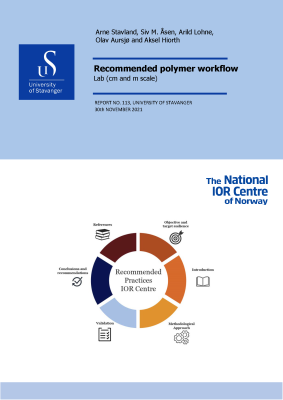Recommended polymer workflow: Lab (cm and m scale)
Keywords:
The National IOR Centre of Norway, polymer flooding, fractional flow analysisSynopsis
Polymer flooding is one of the most promising EOR methods (Smalley et al. 2018). It is well known and has been used successfully (Pye 1964; Standnes & Skjevrak 2014; Sheng et al. 2015). From a technical perspective we recommend that polymer flooding should be considered as a viable EOR method on the Norwegian Continental Shelf for the following reasons:
1. More oil can be produced with less water injected; this is particularly important for the NCS which are currently producing more water than oil
2. Polymers will increase the aerial sweep and improve the ultimate recovery, provided a proper injection strategy
3. Many polymer systems are available, and it should be possible to tailor their chemical composition to a wide range of reservoir conditions (temperature and salinity)
4. Polymer systems can be used to block water from short circuiting injection production wells
5. Polymer combined with low salinity injection water has many benefits: a lower polymer concentration can be used to reach target viscosity, less mechanical degradation, less adsorption, and a potential reduction in Sor due to a low salinity wettability effect.
There are some hurdles when considering polymer flooding that needs to be considered:
1. Many polymer systems are not at the present considered as green chemicals; thus, reinjection of produced water is needed. However, results from polymer degradation studies in the IORCentre indicates that
a. High molecular weight polymers are quickly degraded to low molecular weight. In case of accidental release to the ocean low molecular weight polymers are diluted and the lifetime of the spill might be quite short. According to Caulfield et al. (2002) HPAM is not toxic, and will not degrade to the more environmentally problematic acrylamide.
b. In the DF report for environmental impact there are case studies using the DREAM model to predict the transport of chemical spills. This model is coupled with polymer (sun exposure) degradation data from the IORCentre to quantify the lifetime of polymer spills. This approach should be used for specific field cases to quantify the environmental risk factor.
2. Care must be taken to prepare the polymer solution offshore. Chokes and vales might be a challenge but can be mitigating according to the results from the large-scale testing done in the IORCentre (Stavland et al. 2021).
None of the above-mentioned challenges are server enough to not consider polymer flooding. HPAM is neither toxic, nor bio-accumulable, or bio-persistent and the CO2 footprint from a polymer flood may be significantly less than a water flood (Dupuis et al. 2021). There are at least two contributing factors to this statement, which we will return in detail to in the next section i) during linear displacement polymer injection will produce more oil for the same amount of water injected, hence the lifetime of the field can be shortened ii) polymers increase the arial sweep reducing the need for wells.
References
https://doi.org/10.2118/190410-MS
Caulfield, M.J., Qiao, G.G. & Solomon, D.H. 2002. Some aspects of the properties and degradation of polyacrylamides. Chemical reviews, 102, 3067-3084.
https://doi.org/10.1021/cr010439p
Clarke, A., Howe, A.M., Mitchell, J., Staniland, J. & Hawkes, L.A. 2016. How viscoelastic-polymer flooding enhances displacement efficiency. SPE Journal, 21, 0675-0687.
https://doi.org/10.2118/174654-PA
Dupuis, G., Al-Khoury, P., Nieuwerf, J. & Favero, C. 2021. Using Polymer EOR to Reduce Carbon Intensity While Increasing Oil Recovery. IOR 2021. European Association of Geoscientists & Engineers, 1-19.
https://doi.org/10.3997/2214-4609.202133048
Dykstra, H. & Parsons, R. 1950. The prediction of oil recovery by water flood. Secondary recovery of oil in the United States, 2, 160-174.
Gathier, F., Christophe, R., Lionel, L. & Antoine, T. 2020. Offshore Polymer EOR Injection Philosophies, Constrains and Solutions. SPE Improved Oil Recovery Conference. Society of Petroleum Engineers.
Nouri, H.H. & Root, P.J. 1971. A study of polymer solution rheology, flow behavior, and oil displacement processes. Fall Meeting of the Society of Petroleum Engineers of AIME. Society of Petroleum Engineers.
https://doi.org/10.2118/3523-MS
Pye, D.J. 1964. Improved secondary recovery by control of water mobility. Journal of Petroleum technology, 16, 911-916.
https://doi.org/10.2118/845-PA
Seright, R. & Skjevrak, I. 2015. Effect of dissolved iron and oxygen on stability of hydrolyzed polyacrylamide polymers. SPE Journal, 20, 433-441.
https://doi.org/10.2118/169030-PA
Sheng, J.J., Leonhardt, B. & Azri, N. 2015. Status of polymer-flooding technology. Journal of Canadian petroleum technology, 54, 116-126.
https://doi.org/10.2118/174541-PA
Smalley, P., Muggeridge, A., Dalland, M., Helvig, O., Høgnesen, E., Hetland, M. & Østhus, A. 2018. Screening for EOR and Estimating Potential Incremental Oil Recovery on the Norwegian Continental Shelf. SPE Improved Oil Recovery Conference. Society of Petroleum Engineers.
https://doi.org/10.2118/190230-MS
Sorbie, K. 1991. Polymer-improved oil recovery.
https://doi.org/10.1007/978-94-011-3044-8
Standnes, D.C. & Skjevrak, I. 2014. Literature review of implemented polymer field projects. Journal of Petroleum Science and Engineering, 122, 761-775.
https://doi.org/10.1016/j.petrol.2014.08.024
Stavland, A., Jonsbråten, H. & Strand, D. 2013. When will polymer viscosity be a design criterion for EOR polymer flooding. IEA-EOR 34th Annual Symposium, 8-11.
Stavland, A., Åsen, S.M., Mebratu, A. & Gathier, F. 2021. Scaling of Mechanical Degradation of EOR Polymers: From Field-Scale Chokes to Capillary Tubes. SPE Production & Operations, 36, 43-56.
https://doi.org/10.2118/202478-PA
Åsen, S.M., Stavland, A., Strand, D. & Hiorth, A. 2019. An Experimental Investigation of Polymer Mechanical Degradation at the Centimeter and Meter Scale. SPE Journal, 24, 1,700-701,713.
https://doi.org/10.2118/190225-PA


